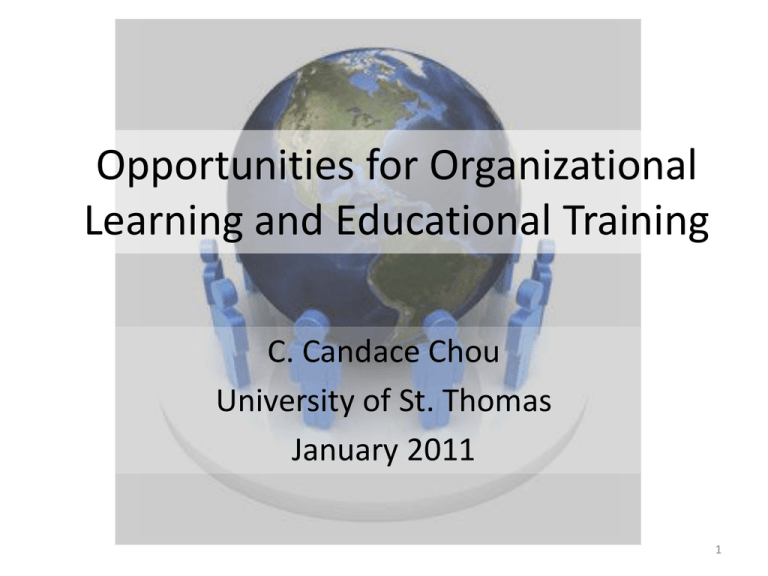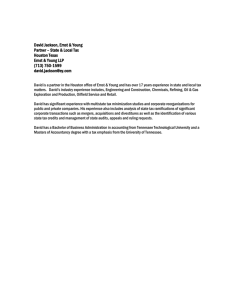Opportunities for Organizational Learning and Educational Training
advertisement

Opportunities for Organizational Learning and Educational Training C. Candace Chou University of St. Thomas January 2011 1 Kolk’s Experiential Learning Cycle Plan Do Observe Think Kolb, David A. 1984. Experiential Learning: Experience as the Source of Learning and Development. Prentice-Hall, Inc., Englewood Cliffs, N.J. 2 Learning by Doing •Developing a new course of action as a result of the experience •Apply the new learning from the experience in real-world situations Generalizing in order to develop abstraction and hypotheses from data generated by the experience Experiencing by taking in data with one’s senses Sharing and/or reflecting about the experience in order to make sense of it, 3 Six Learnings: A framework for curricula design & evaluation Field trip Exploring Conversation starters Team work Expressing Collaborating Championing Being Case study Role-play Building Lim (2009) presentation 4 Why Team-based Experiential Learning • • • • • • Development of relationship Disequilibrium Projection of inner self Increased speed of decision making Meta learning Creation of a safe environment while encouraging risk taking • Embodiment of learning Heiphetz, A., & Woodill, G. (2010) 5 Best Practices • Loyalist College Border Simulation • Michelin Group • IBM China HR new-hire orientation • Ernst & Young auditor training Heiphetz, A., & Woodill, G. (2010 8 Loyalist College Canadian Border Simulation http://www.youtube.com/watch?v=PCUWcpVPtMM 9 Practice Interview Skills 10 28% Better Result 11 Michelin Group Case Study • A global tire manufacturer with factories in 170 countries • Need to develop global standard processes and leverage best practices across the organization. • The challenge was to train two hundred IS professionals in the US. 12 Why • The bad news is that all traditional training approaches failed. – Too many concepts – Not practical – Difficult to understand 13 Second Life Came to the Rescue • A virtual world-based program seems like a practical solution. • Scenarios – A small team of people attending a scheduled course under the supervision of an instructor – A place for individual trainees to come back regularly for practice after attending the course 14 Scenario-Based Learning • Trainees went through a sequence of three workshops first. • The final step is to create a road map for developing and installing the information systems applications. • Trainees engaged in interactive exercises to meet their business targets while not exceeding budget constraints. 15 User Feedback Very true True Somewhat True Not True I understand the EA methodology (%) 60.7 35.6 3.7 Second Life appropriate to learn about EA (%) 59.5 38.0 2.5 0 0 Cost: $100,000 in preparing the training environment in Second Life. 16 Lesson Learned • Total immersion invoked an intense gamelike passion: Trainees would not leave until they had completed all exercises. • Second Life allowed Michelin’s training staff to pack a lot of interactive learning experiences within a very short amount of time, cutting training time. • It is easy to create “reality” in a virtual world; hands-on workshop helped understand concepts and provided immediate feedback 17 IBM Recruit & New Hire Orientation 18 Why • Provide immersive experience in IBM culture, history, and organization and promote team spirit by collaboration • Developed by IBM China HR team • 600 participants 19 Learning Activities • Blue Pathway Exhibition Hall: A 3D space for candidates to review IBM history, organization, values, career development, securities, and other information. • Blue Pathway Summer Island: A team-based content co-creation project. The virtual teams planned, designed, and developed contents on separate parts of the island. 20 Formats • Synchronous meetings • Access self-paced asynchronous learning materials any time • Organized team-building, collaboration, and leadershipbuilding activities that strengthened corresponding skills. 21 Feedback • High levels of satisfaction from post project interviews • Tremendous cost saving compared to real-life events • Significant measureable reduction in spending required to orient new hires 22 1. Simulation: Ernst & Young Cookie Factory for Auditors •A global consulting and accounting company in more than 140 companies with more than $24B in revenue •Experimental training exercise for junior auditors http://2b3d.net/eymovie.htm Ernst & Young • The Challenge – New hires spent an average of 130 hours mostly in the classroom training during the first year – Inventory observation (IO) is the essential skills – Not all new accountants master the process when they are on the ground • Why 3D – Develop various scenarios to help new auditors through a 3D learning experience. Graphic: http://www.brandon-hall.com/workplacelearningtoday/?p=4357 24 Ernst & Young • Making the case – Conduct a pilot to address 2 questions 1. Can participants learn as much as they do in F2F classes 2. Does completing a ILE (immersive learning experience) more effectively prepare the participants than a traditional ILT (instructor-led training)? Graphic: http://www.brandon-hall.com/workplacelearningtoday/?p=4357 25 • The solution – Orientation – Content learning via videos, information kiosks, and interactive games – Tour the factory – Begin inventory observation process – Conclude with final compilation activity 26 •The Results and Lesson Learned •3-D learning better prepared new auditors •Cost-effective alternative to on-site training •Capture the knowledge of retiring professionals •Need proper orientation and computers for staff http://www.outsourcing-journal.com/mar2009-acs.html?email011369 References • Heiphetz, A., & Woodill, G. (2010). Training and collaboration with virtual worlds: How to create costsaving, effecient, and engaging programs. New York: McGraw Hill. • Lim, K. Y. T. (April 2009). The Six Learnings of Second Life: A framework for designing curricular interventions in-world [Electronic Version]. Journal of Virtual Worlds Research, 2. Retrieved April 17, 2009 from http://jvwresearch.org/. • Zielke, M. A., Roome, T. C., & Krueger, A. B. (April 2009). A Composite Adult Learning Model for Virtual World Residents with Disabilities: A Case Study of the Virtual Ability Second Life® Island [Electronic Version]. Journal of Virtual Worlds Research, 2(1). Retrieved April 17, 2009 from http://jvwresearch.org/. 29


